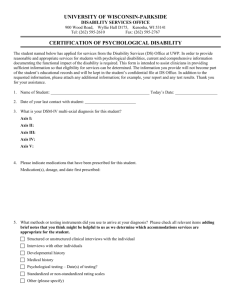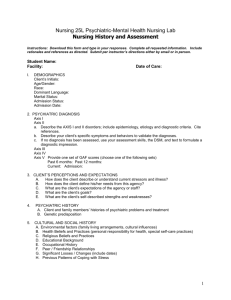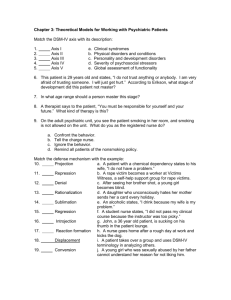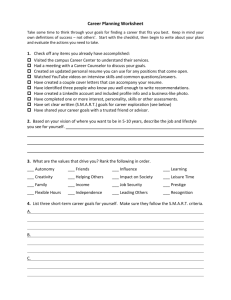MH Assessments - UNC School of Social Work
advertisement
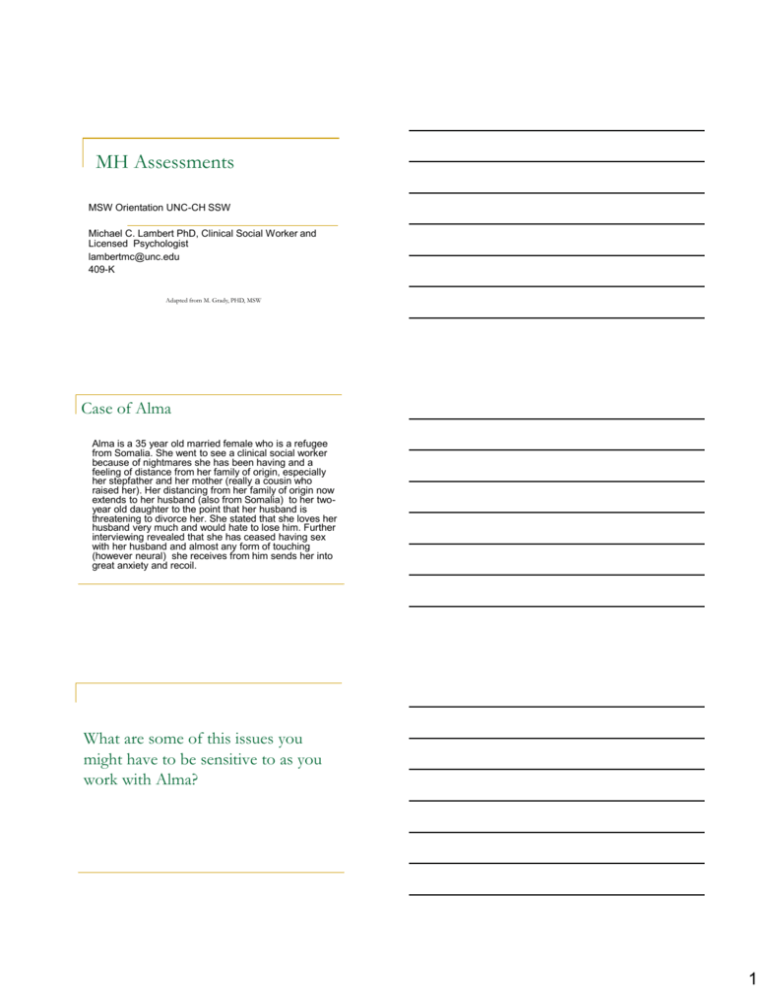
MH Assessments MSW Orientation UNC-CH SSW Michael C. Lambert PhD, Clinical Social Worker and Licensed Psychologist lambertmc@unc.edu 409-K Adapted from M. Grady, PHD, MSW Case of Alma Alma is a 35 year old married female who is a refugee from Somalia. She went to see a clinical social worker because of nightmares she has been having and a feeling of distance from her family of origin, especially her stepfather and her mother (really a cousin who raised her). Her distancing from her family of origin now extends to her husband (also from Somalia) to her twoyear old daughter to the point that her husband is threatening to divorce her. She stated that she loves her husband very much and would hate to lose him. Further interviewing revealed that she has ceased having sex with her husband and almost any form of touching (however neural) she receives from him sends her into great anxiety and recoil. What are some of this issues you might have to be sensitive to as you work with Alma? 1 Typical issues you might Language issues – translation and how meaning can get lost Acculturation issues Power differences (role, gender, class, size) Setting Voluntary vs. involuntary services Who is the client? The person with you or another agency (e.g., court, DSS) and impact on intervention Safety issues (psychological and physical) Maintaining a safe/manageable pace How do you manage it when you are offended or impacted in some way by the client or his/her behavior? Differences vs. similarities to the client Disabilities – visual vs. invisible Theoretical orientation considerations Biopsychosocial Assessment Social work framework Focus is on the person-inenvironment Cannot separate individual/family from the context in which the client(s) live, including: Social context (class, family system, etc.) Cultural context (acculturation, language, etc.) Attitudes of culture of origin vs. host culture Biological Client(s) Psychological Social Spiritual context (belief systems, ideas about healing, etc.) Plus more! Biological Realm What are the medical issues that help me understand the client/situation? What genetic/family Hx of illness can I use to help understand the vulnerabilities of this individual/family system? What stage of life factors might be at play, i.e. how close to delivery a baby or how old is this person? Are there medical concerns that I can rule out or do I need to make a referral to a medical professional? 2 Psychological Realm What are the psychological theories that inform my understanding of this case? What factors do I need to think about when helping to understand this case? patterns of relationships cognitive processes trauma history family history Behavioral patterns Psychological Theories play an important role in understanding the etiology of many disorders vs. giving a description of symptoms. Different theories help guide your questions and can more concisely target your questions in the assessment Theories help you to understand the WHY of situation, rather than only describe what you are seeing. Where did these symptoms come from? What purpose do they serve? Social Realm There are social theories that help inform how society and social factors influence individuals, families and groups to behave and respond in certain ways, i.e. Anomie from Durkheim. Cultural/Spiritual factors and critical in understanding how groups understand illness and especially mental illness. What are the origins of an illness? An evil spirit? Voodoo? Germs? Will of God? How will the group respond? Are they ostracized? Seen as special? Cared for differently? Class plays a role in access to services and how much stress individuals feel, which may lead to additional illnesses or more serious courses of certain illnesses. What is their social network like and how does that influence their current situation? Race inextricably linked to class. Why? How might social network be influenced by culture? Strengths Often when someone comes in for help around an illness, mental or physical, they are focused on what is wrong. What is strength? The capacity to cope including resilience Where, when and how are the strengths used? How do these strengths fit with their culture vs. the dominant culture? What are the external sources of strengths, vs. just internal resources? Areas to consider: What is the ability to perceive, analyze and comprehend what is happening? How are their coping skills? What ways are they able to manage stress? What are the temperamental and dispositional factors that help this individual? How do they see the world? What are their interpersonal skills that support their ability to develop and maintain supportive social networks? How does culture impact strengths? 3 So, now what? What does this mean when you are sitting with someone? What should you be asking or finding out? Many ways to skin a cat… Multiple ways to do an assessment Unless have unlimited time with a client, will always miss something regardless of what you do. No one method of assessment is perfect – each focus on certain areas, and may miss something. People get more specific based on what questions asking Appropriateness for a program Need to determine a specific diagnosis Determination of eligibility for a disability Can be even done outside the office in places such as home, school, job You will get better at it! Always remember… “We are making an interpretation of an interpretation” (Kleinman, 1997). Social workers make interpretations of the client’s interpretations of what is going on for him/herself. Both of these interpretations are through the individuals lens, influenced by culture, gender, class, history, etc. Regardless of what method of assessment you are using, remember that you are using a tool (which may be you) to interpret someone else’s experience. Every tool has biases! 4 Assessment Methods Interviews With client(s) With collateral contacts Structured vs. unstructured Standardized forms Beck Depression Inventory Hamilton Depression Scale Physical exams Physicians complete a medical exam Tests that test physical reactions Psychological assessments Combination of interviews, forms and task based examinations (includes personality testing, IQ testing, neuropsych) Regardless of Method Important to establish a rapport Worker needs to have genuine curiosity Client will only share when feel comfortable and safe Chief complaint what is the presenting problem Why are they coming in NOW with it? What has changed? Important to learn how to discuss tough topics (ETOH use; changes in relationship, including sexual; hallucinations/delusions; suicide) Remember to find out their strengths (external or internal) Give patient chance to answer questions Sum up interview with something positive or some sort of hope tapping into a strength. Follow through on what you say you are going to do! Components of a MH Assessment Reason for Evaluation Why are they there? Why now? Who sent them? Why? What do they hope to gain from it? History of Present Illness Current symptoms When symptoms/problems appeared Any current treatment for present issue? What does client see as potential cause for current situation? (American Psychiatric Association, 1995) 5 Past mental health history General Medical History What medical conditions could be contributing to the current mental health conditions? Any chronic medical conditions? Other past medical procedures? History of Substance Use Mental health experiences in the past Past occurrences, plus other treatment experiences, inpatient, outpatient, medications and the lengths and successes of those treatments. Past and present use of substances Specifically, amounts, patterns of use, frequency, etc. Psychosocial/Developmental History (Personal History) Stages of life issues Family roles, past and present (partner status, parenting, # of children, birth order, etc.) Developmental milestone history Education Cultural influences/experiences Trauma history Sexual history Social History Living arrangements Social agency involvements Legal issues/involvements Occupational History Job status Job history Military history Family History Medical and psychiatric history of family members Includes past difficulties and past treatments Review of Symptoms/Difficulties Physical Exam Any other issues not discussed in presenting complaint Completed by a physician Social Workers should find out the last time the client(s) saw a physician for an exam Functional Tests Tests that give information as to how well individual is functioning, i.e. using the toilet, doing self-care, daily living skills, like taking medications, attending school Discussed often with people who have chronic illness or where there has been a decline in their functioning. 6 Mental Status Exam Part of an assessment Provides a “snapshot” of the individual Can be used to compare how the individual’s level of functioning has changed over the course of short or long periods of time. Based purely on observations during an interview Depending on setting and purpose of interview, MSE may be more or less detailed. Components of MSE Appearance and general behavior Expressions of mood and affect Characteristics of speech and language Mood is internal state reported by client Affect is what is seen externally by others Clear vs. pressured speech Appropriate use of language Motor activity Appeared agitated or demonstrated motor retardation Unusual movements (American Psychiatric Association, 1995) Current thoughts and perceptions Expressed worried/concerns Cognitive and perceptual symptoms (delusions, hallucinations, obsessions, compulsions, etc.) Suicidal, homicidal, violent or self-injurious thoughts, feelings, or impulses Client’s associations Client’s understanding of current situation Thoughts clear or contradictory statements? (American Psychiatric Association, 1995) 7 Cognitive Status Level of consciousness Orientation (X 4) (person, place, time, purpose) Attention and concentration Language functions (reading, comprehensions, etc.) Memory (short and long-term) General knowledge (appropriate to sociocultural and educational background) Calculations Appropriate to education attainment Can do any combination (7s, 3s) Drawing (clock face, a person) Executive functions (list making, resisting distractions) Quality of judgment and insight (American Psychiatric Association, 1995) MSE Example Anna was neatly dressed and was cooperative during the interview and appeared her stated age. She stated that she felt “depressed” and “down” most days and her affect was congruent with her stated mood. Her speech was delayed, but her motor activity appeared to be within normal limits. Her thoughts centered around her guilt concerning her husband’s incarceration and worries for her children. She denied any delusions, hallucinations, obsessions or compulsions. She also denied any suicidal, homicidal, or self-injurious ideation. Her associations were clear, although her understanding of the current situation is distorted, as she blames herself for her husband’s sentence. She was alert during the interview and oriented x3 (person, place, and time) but seemed confused as to what the purpose of the evaluation was. She appeared to lose her concentration several times during the interview and often needed to have the questions repeated for her. Her language functions were intact and her memory both short- and long-term were within normal limits. Her general knowledge was appropriate, but had difficulties with some executive functions (e.g. unable to keep track of follow-up tasks). She appeared to have little insight into her current situation, given the extreme nature of her ex-husband’s actions. Drawing and calculations were not completed during the interview. Progress Notes SOAP notes or some variants of it are fast being considered standard, especially to third party payees S – subjective O – Objective Assessment P-Plan 8 Soap note Example S: Sophie stated “I am so disgusted with myself for going back to her [her partner] again, especially considering how bad she treated me in the past” O: The client appropriately dressed and maintained good eye contact except for when she expressed shame about resuming a relationship with her partner. She was sometimes angry and tearful during different parts of the session, especially when she spoke about the manner in which she was treated by her partner. A: Sophie has gained insight into her behavior as it pertains to sabotaging herself in her intimate relationships. P: She has completed a half of the first treatment goal. Patient will continue working on the next half of the treatment goal As a social worker!!!! Remember Strengths! Think about the impact of social justice issues Consider the impact of discrimination and other inequality issues (race, gender, sexual orientation, age, class) How does their world/spiritual view impact their way of being in the world Cultural beliefs about the medical/mental health community Discrimination factors that may impact course of illness or comfort level in discussing concerns, i.e. fear of homophobia by interviewer. Remember – What are the biases that YOU bring to the relationship? How does that influence the way you interpret their symptoms, strengths, problems, situation, etc.? Diagnosing!?!?!?! To diagnose or not diagnose. That is the question! 9 Kleinman Recommendations re: Cultural Competence in DSM Needs to be a better introduction cautioning users of the biases Should be an axis for acculturation or cultural obstacles For each disease, there should be a section on cultural limitations Give examples of how symptoms are expressed across the world Culture-Bound Syndromes should be included, i.e. refugee camp survivors Information on interpreters needs to be included Case examples on cross-cultural cases should be included Include information on how culture influences practitioner (Kleinman, 1997) The 5-Axis System Axis I: Axis II: Axis III: Axis IV: Axis V: Clinical Disorders Other Conditions that May Be Focus of Clinical Attention Personality Disorders Mental Retardation General Medical Conditions Psychosocial and Environmental Problems Global Assessment of Functioning Axis I Issues Generally, these are the issues people come in to treatment for. What most people think of as treatable, therapy issues. 10 Axis II Issues Thought to originate in childhood. Many people think of individuals with these diagnoses as “untreatable”, but that is a bias. Axis III Issues Any medical condition, such as diabetes, history of stroke, etc. Axis IV Issues (The DSM categorizes them into groups, but they can be listed as individual issues.): Problems with Primary Support Group – death in the family; Sexual or physical abuse. Problems Related to Social Environment – discrimination; adjustment to life-cycle transition. Economic Problems – extreme poverty; insufficient welfare support. This the “Social Work” section of the diagnoses. List the biopsychosocial issues that may be impacting the individual. 11 Axis V Issues Reports the clinician’s judgment of the individual’s overall functioning “This information is useful in planning treatment and measuring its impact and in predicting outcome.” Sometimes used as a general measurement of treatment success by managed care companies and hospitals. Often asked to list: “Current” “Highest Level in Past Year” “Lowest Level in Past Year” “At time of Discharge” “At time of Admission” Axis V scoring continued Scores are listed in 10 point intervals -> each time you go up or down by 10, you are in a different category of symptoms. Score of 100 = “No Symptoms” Score of 0 = Inadequate information Score of 1-10 = Persistent danger of severely hurting self or others OR persistent inability to maintain minimal personal hygiene OR serious suicidal act with clear expectation of death. 12



